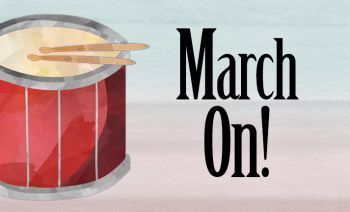March On! 3•1•2020
PROGRAM
Garland Entrée March, by Karl L. King
Karl L. King (1891–1971) spent many years as a circus musician, playing baritone in the famous circus bands of the day and eventually becoming conductor of the Barnum and Bailey Circus Band. He composed “Garland Entrée March” in 1912, early in his circus career, and dedicated the piece to Walter P. English, bandmaster of Sells–Floto Circus. A so-called garland entry was the music for the grand entry to the circus, during which all the participants wore garlands of flowers. King wrote nearly 300 pieces during his lifetime—among them, some 200 marches.
The National Game, by John Philip Sousa (arr. Keith Brion)
John Philip Sousa (1854–1932) composed 136 marches during his lifetime and became known as “America’s March King.” He wrote “The National Game” in 1925 at the request of baseball’s first commissioner, Kenesaw Mountain Landis, to celebrate the National League’s fiftieth anniversary. Landis served as baseball commissioner from 1920 until his death in 1932 and helped restore public confidence in the game following the Black Sox scandal of 1919. In 1921, he banned eight members of the Chicago White Sox from organized baseball.
The Florentiner March, by Julius Fučik (arr. M. L. Lake/ed. Frederick Fennell)
Julius Fučik (1872–1916) wrote primarily for military bands and is sometimes referred to as the “Bohemian Sousa.” The Czech composer wrote more than 400 works, but he is best known for two marches: “The Florentiner March” and “Entrance of the Gladiators.” Fučik wrote “The Florentiner March” in 1907 in condensed operetta style. The piece pays tribute to Florence, Italy, and bears the subtitle “Grande Marcia Italiana.”
Nick Smith, guest conductor
Gallito, by Santiago Lope (ed. Roy J. Weger)
Santiago Lope Gonzalo (1871–1906), a Spanish composer, wrote 40 or so pieces during his short lifetime, including a series of pasodobles: lively dances in march-like duple meter. The pasodoble originated from a fast-paced Spanish military march (pasodoble means “double step”) and evolved into the style of music typically played during a bullfighter’s entrance to the ring. “Gallito” is the most often performed of Lope’s pasodobles and is dedicated to Fernando Gómez Ojeda, a talented young matador who was killed during a bullfight.
Old Comrades, by Carl Teike (ed. John R. Bourgeois)
Carl Teike (1864–1922) composed more than 100 military marches and 20 concert works. He wrote “Old Comrades” in 1889, when he was a young German soldier, to honor the loyalty established between comrades-at-arms—a bond that remains strong long after their military experiences. Although “Old Comrades” was initially rejected by one of Teike’s superiors, it has become one of the most popular marches in the world.
Homage March, by Richard Wagner (ed. John R. Bourgeois)
Richard Wagner (1813–1883) wrote “Homage March” in 1864 for the nineteenth birthday of King Ludwig II of Bavaria. Composed for the wind band, this grand march was the first of three written by Wagner and one of only several nonoperatic works by the German composer. As such, it has been called his “principal contribution” and “most satisfying” work for band. In editing “Homage March” to include modern instrumentation, John R. Bourgeois worked to maintain the original themes of the work.
Intermission
Flight, by Claude T. Smith
Claude T. Smith (1932–1987) wrote more than 110 pieces for band, including several prestigious commissioned works for U.S. military bands. “Flight” is the official march of the Air and Space Museum, which is part of the Smithsonian, in Washington, DC. The U.S. Air Force Band commissioned and then premiered the work in 1984, and their recording is heard as visitors enter the museum. Pachelbel’s “Canon” is featured in the opening section of “Flight” before the brass introduces a soaring theme.
Crown Imperial: A Coronation March 1937, by William Walton
William Walton (1902–1983) composed “Crown Imperial,” an orchestral march, for the May 12, 1937, coronation of King Edward VIII. However, Edward abdicated in December 1936, and so his brother was crowned instead as King George VI. The march was significantly revised in 1953 and performed at the coronation of King George’s daughter and successor, Queen Elizabeth II. When “Crown Imperial” was released, critics described it as “unrepresentative” of Walton’s clear, brilliant, avant-garde style, yet it is generally regarded as his most popular orchestral composition.
The Girl I Left Behind Me Traditional (arr. Leroy Anderson)
Leroy Anderson (1908–1975) became famous for his association with the Boston Pops Orchestra, which premiered many of his works under the direction of Arthur Fiedler. Among those works was Irish Suite (written in 1947), a six-movement piece featuring themes from well-known Irish folk tunes. “The Girl I Left Behind Me” dates back to the late 1500s and was traditionally played when soldiers went off to war or a naval ship set sail. Over time, British and American soldiers adopted versions of the song, and it is still played as part of a medley at graduation ceremonies at the U.S. Military Academy at West Point.
Nick Smith, guest conductor
Midway March John Williams (trans. Paul Lavender)
John Williams (b. 1932) has composed the music and served as the music director for 80-plus films, including the 1976 hit Midway. That film, shot in a documentary style, chronicled the historic World War II battle in which the U.S. Navy handed the Imperial Japanese Navy its first defeat in 80 years. Williams was eager to take on the project, in part because the soundtrack used a new technology called Sensurround to enhance the physical sensations of engines, explosions, crashes, and gunfire. However, given the movie’s documentary style, it didn’t involve much music. Williams wrote only two themes: one military, the other pastoral. “Midway March” presents the military theme, a spirited, lilting, patriotic march that has been described as “Sousa-esque.”
Program notes by Susan Freese
Upcoming Performances
Join our mailing list
Subscribe to our email newsletter to learn about upcoming concerts.


